Club Night Report
Wednesday 11th March 2015
Club Night Report for 11th March 2015 - observations by Vernon Hughes |
 |
 |
 |
 |
 |
Our speaker, Terry Smart of 'Chestnut Products' nailed his colours to the mast at the outset by emphasizing that he is a Finisher of Turned Work and NOT A Woodturner. He might manage a mushroom but relies on a real turner to make any pieces needed for demonstration purposes. His detailed knowledge of finishing materials and techniques proved to be comprehensive. However, even after many years in the business; he recommended that we look at the Chestnut Products website at www.chestnutproducts.co.uk to further familiarize ourselves about the range and uses of products available. He also reminded us that there would be the usual Chestnut stand at the forthcoming Yandles show at Martock (April 10th/11th) which would be an ideal opportunity for one-to-one discussion of needs. (Note: A convenient means of clearing the mind on the extensive range of Chestnut products is to look up the Price List page on the website; all the items are listed/ grouped in a readily digestible order).
For demonstration purposes Terry used two forms (prepared earlier), viz: cylinders of approx. 10" length x 2" diameter and small vase shapes. Products used/ demonstrated during the evening were: abrasives (including velcro backed and strongly recommended Nyweb at 400, 800 and 1000 grit), tack cloth, sanding sealers (several formulations), proprietary white absorbent paper (similar to, but better than kitchen roll), burnishing cream, wax polishes (including Microcrystalline), melamine lacquer, other lacquers including an ebonizing type, gilt cream, friction polish and, finally the Chestnut buffing wheel kit. Oils were mentioned.
Terry started with a cylinder and emphasized the importance of surface preparation in order to get the finish right. He used abrasives through the grades working with the grain and with the lathe static. Dust was then removed with a tack cloth and he advised that these cloths, which are impregnated with a non-wood-penetrating resin, should be kept in a glass jar to prevent premature drying out. He then emphasised the importance of sealing no matter how good a surface has been achieved with the tools and abrasives, except when applying an oil finish. He applied thin coats using the absorbent paper rather than a brush, de-nibbing with fine abrasive after each coat, and recommended making a discipline of always screwing tin lids back on every time. Tins are so easily knocked over accidentally whilst focus is on other matters! He then moved through burnishing cream to wax polish and passed the polished cylinder round for inspection. In response to a question he explained that despite its thickish texture sanding sealer is NOT designed to be thinned, but that as evaporation takes effect over time thinning by no more than 10-20% is permissible. Similarly with wax polishes they can be softened with white spirit if necessary as they tend to harden in the bottom third of the tin. Note though that all these products carry a use-by date. Wax should be applied in thin coats. Another interesting point was that once applied, conventional wax polishes will soften due to hand heat but this does not occur with Microcrystalline waxes because they have a higher melting point. They contain a different solvent which takes 20 minutes to harden but results in a more durable finish.
 |
 |
 |
 |
The demonstration continued using another cylinder that was treated with sanding sealer and melamine lacquer followed by burnishing cream. Terry observed that melamine demands greater care in use and that up to three thin coats can be applied but no more. Tin lids are often known to stick hard - requiring grips (keep them handy) for removal. There was then a description of the constituents of friction polish with a mention that burnishing cream can be applied on top and also to any other finishes that have dried hard.
Lacquers were dealt with next and one of the small vase shapes was used as the subject for this part of the talk. The effect displayed in the photograph shows the result obtained using ebonizing lacquer followed by several coats of gold gilt cream (silver and copper are also available). There was a final finish with hard wax oil. Terry talked about oils briefly before turning to his final product of the evening, the buffing wheel kit. This was explained thoroughly, and demonstrated using the bottom front quarter of the wheel as the point of contact with the items to be buffed. At an all-in cost of £55, and with wheels that last 'for ever' this gave every indication of being a very worthwhile investment.
This had been another thoroughly enjoyable evening. A seemingly narrow subject proved to be anything but - due to Terry Smart's breadth of knowledge and skilful presentation.
<Top of Page>
The Show and Tell theme for the evening was: A Bowl - this was well supported and displayed some interesting pieces.
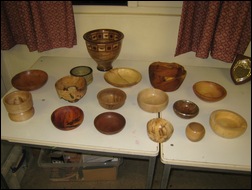 |
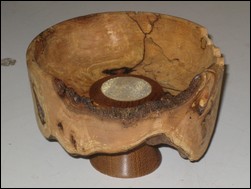 |
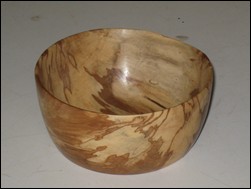 |
 |
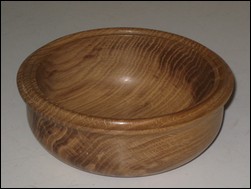 |
 |
| Second place was awarded to David Branscombe with a fine pyrographed bowl |
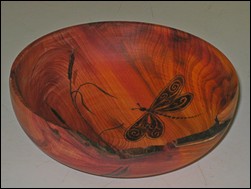 |
| This month's Show and Tell winner was Roger Hoare with a superb large segmented bowl. He explained that it had been quite a challenge - and he had tried (with success) lots of new features such as stars, zig-zags and veneers. |  |
 |
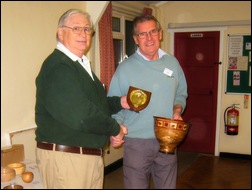 |
<Top of Page>
